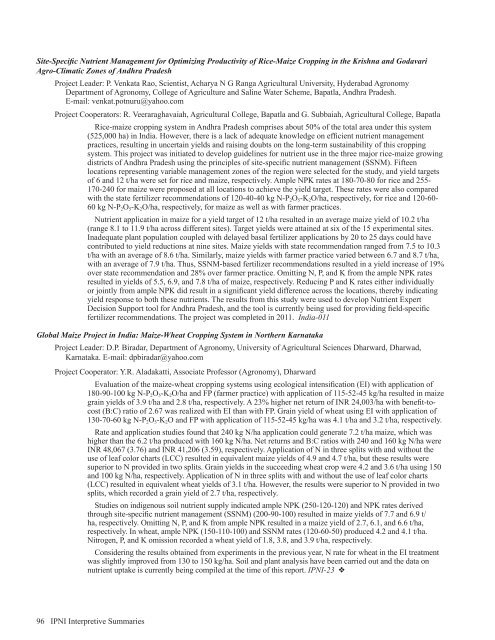Americas and Oceania Group - International Plant Nutrition Institute
Americas and Oceania Group - International Plant Nutrition Institute
Americas and Oceania Group - International Plant Nutrition Institute
Create successful ePaper yourself
Turn your PDF publications into a flip-book with our unique Google optimized e-Paper software.
Site-Specific Nutrient Management for Optimizing Productivity of Rice-Maize Cropping in the Krishna <strong>and</strong> Godavari<br />
Agro-Climatic Zones of Andhra Pradesh<br />
Project Leader: P. Venkata Rao, Scientist, Acharya N G Ranga Agricultural University, Hyderabad Agronomy<br />
Department of Agronomy, College of Agriculture <strong>and</strong> Saline Water Scheme, Bapatla, Andhra Pradesh.<br />
E-mail: venkat.potnuru@yahoo.com<br />
Project Cooperators: R. Veeraraghavaiah, Agricultural College, Bapatla <strong>and</strong> G. Subbaiah, Agricultural College, Bapatla<br />
Rice-maize cropping system in Andhra Pradesh comprises about 50% of the total area under this system<br />
(525,000 ha) in India. However, there is a lack of adequate knowledge on efficient nutrient management<br />
practices, resulting in uncertain yields <strong>and</strong> raising doubts on the long-term sustainability of this cropping<br />
system. This project was initiated to develop guidelines for nutrient use in the three major rice-maize growing<br />
districts of Andhra Pradesh using the principles of site-specific nutrient management (SSNM). Fifteen<br />
locations representing variable management zones of the region were selected for the study, <strong>and</strong> yield targets<br />
of 6 <strong>and</strong> 12 t/ha were set for rice <strong>and</strong> maize, respectively. Ample NPK rates at 180-70-80 for rice <strong>and</strong> 255-<br />
170-240 for maize were proposed at all locations to achieve the yield target. These rates were also compared<br />
with the state fertilizer recommendations of 120-40-40 kg N-P 2 O 5 -K 2 O/ha, respectively, for rice <strong>and</strong> 120-60-<br />
60 kg N-P 2 O 5 -K 2 O/ha, respectively, for maize as well as with farmer practices.<br />
Nutrient application in maize for a yield target of 12 t/ha resulted in an average maize yield of 10.2 t/ha<br />
(range 8.1 to 11.9 t/ha across different sites). Target yields were attained at six of the 15 experimental sites.<br />
Inadequate plant population coupled with delayed basal fertilizer applications by 20 to 25 days could have<br />
contributed to yield reductions at nine sites. Maize yields with state recommendation ranged from 7.5 to 10.3<br />
t/ha with an average of 8.6 t/ha. Similarly, maize yields with farmer practice varied between 6.7 <strong>and</strong> 8.7 t/ha,<br />
with an average of 7.9 t/ha. Thus, SSNM-based fertilizer recommendations resulted in a yield increase of 19%<br />
over state recommendation <strong>and</strong> 28% over farmer practice. Omitting N, P, <strong>and</strong> K from the ample NPK rates<br />
resulted in yields of 5.5, 6.9, <strong>and</strong> 7.8 t/ha of maize, respectively. Reducing P <strong>and</strong> K rates either individually<br />
or jointly from ample NPK did result in a significant yield difference across the locations, thereby indicating<br />
yield response to both these nutrients. The results from this study were used to develop Nutrient Expert<br />
Decision Support tool for Andhra Pradesh, <strong>and</strong> the tool is currently being used for providing field-specific<br />
fertilizer recommendations. The project was completed in 2011. India-011<br />
Global Maize Project in India: Maize-Wheat Cropping System in Northern Karnataka<br />
Project Leader: D.P. Biradar, Department of Agronomy, University of Agricultural Sciences Dharward, Dharwad,<br />
Karnataka. E-mail: dpbiradar@yahoo.com<br />
Project Cooperator: Y.R. Aladakatti, Associate Professor (Agronomy), Dharward<br />
Evaluation of the maize-wheat cropping systems using ecological intensification (EI) with application of<br />
180-90-100 kg N-P 2 O 5 -K 2 O/ha <strong>and</strong> FP (farmer practice) with application of 115-52-45 kg/ha resulted in maize<br />
grain yields of 3.9 t/ha <strong>and</strong> 2.8 t/ha, respectively. A 23% higher net return of INR 24,003/ha with benefit-tocost<br />
(B:C) ratio of 2.67 was realized with EI than with FP. Grain yield of wheat using EI with application of<br />
130-70-60 kg N-P 2 O 5 -K 2 O <strong>and</strong> FP with application of 115-52-45 kg/ha was 4.1 t/ha <strong>and</strong> 3.2 t/ha, respectively.<br />
Rate <strong>and</strong> application studies found that 240 kg N/ha application could generate 7.2 t/ha maize, which was<br />
higher than the 6.2 t/ha produced with 160 kg N/ha. Net returns <strong>and</strong> B:C ratios with 240 <strong>and</strong> 160 kg N/ha were<br />
INR 48,067 (3.76) <strong>and</strong> INR 41,206 (3.59), respectively. Application of N in three splits with <strong>and</strong> without the<br />
use of leaf color charts (LCC) resulted in equivalent maize yields of 4.9 <strong>and</strong> 4.7 t/ha, but these results were<br />
superior to N provided in two splits. Grain yields in the succeeding wheat crop were 4.2 <strong>and</strong> 3.6 t/ha using 150<br />
<strong>and</strong> 100 kg N/ha, respectively. Application of N in three splits with <strong>and</strong> without the use of leaf color charts<br />
(LCC) resulted in equivalent wheat yields of 3.1 t/ha. However, the results were superior to N provided in two<br />
splits, which recorded a grain yield of 2.7 t/ha, respectively.<br />
Studies on indigenous soil nutrient supply indicated ample NPK (250-120-120) <strong>and</strong> NPK rates derived<br />
through site-specific nutrient management (SSNM) (200-90-100) resulted in maize yields of 7.7 <strong>and</strong> 6.9 t/<br />
ha, respectively. Omitting N, P, <strong>and</strong> K from ample NPK resulted in a maize yield of 2.7, 6.1, <strong>and</strong> 6.6 t/ha,<br />
respectively. In wheat, ample NPK (150-110-100) <strong>and</strong> SSNM rates (120-60-50) produced 4.2 <strong>and</strong> 4.1 t/ha.<br />
Nitrogen, P, <strong>and</strong> K omission recorded a wheat yield of 1.8, 3.8, <strong>and</strong> 3.9 t/ha, respectively.<br />
Considering the results obtained from experiments in the previous year, N rate for wheat in the EI treatment<br />
was slightly improved from 130 to 150 kg/ha. Soil <strong>and</strong> plant analysis have been carried out <strong>and</strong> the data on<br />
nutrient uptake is currently being compiled at the time of this report. IPNI-23 v<br />
96 IPNI Interpretive Summaries

















